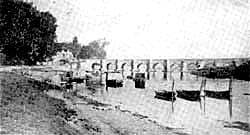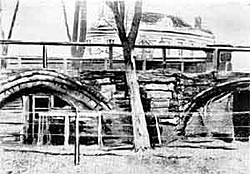Old Trent Bridge
 |
To set down the history of Trent Bridge, or Hethbeth Bridge as it was called during the Middle Ages, in a few words, would be an impossible task, for its story is as fascinating and full of interest as it is long.
It is interesting to remember that it is not the Nottingham bridge, for it stands more than a mile away from the ancient town, whose inhabitants did not greatly concern themselves about it.
There always seems to have been a crossing of the Trent hereabouts, and this crossing was of such importance that a thousand years ago (in 924, to be precise), Edward the Elder, Alfred the Great’s son, erected the first bridge here. The importance of the event may be judged from the fact that the construction of no other bridge is mentioned in the Anglo-Saxon Chronicle between the departure of the Romans and the coming of the Normans.
 |
Whatever Edward’s bridge was like, it served its purpose, and was no doubt constantly being repaired for four hundred years, until about 1300 it was taken in hand and tended by Alice le Palmer, wife of the Mayor of Nottingham. She seems to have devoted her whole life to its upkeep, although nominally it was in the care of the brethren of St. John of Jerusalem, whose hospital stood where the Palais de Danse is now erected. The bridge, as was usual, carried a chapel, like the one still standing at Bradford-on-Avon, where wayfarers were expected to pay a sort of religious toll ‘as a thank offering for a safe journey.
When the Hospital of St. John was dissolved by Edward VI., he granted its lands, together with the alms of this chapel, to the Corporation of Nottingham for the upkeep of Trent Bridge and so laid the foundations of the Bridge Estate. The subsequent history of the bridge is too complicated to be entered into here, but in 1871 it had become too antiquated for the traffic it had to carry, and a new and modern bridge was erected. Mercifully one arch of the old bridge was preserved by our fathers when they built their new structure, so that we and succeeding generations may be able to visualise the old Hethbeth Bridge. This arch has been dated 1364 – while the Black Prince was alive.
Just think of all the great men and women who must have passed over it since then!
